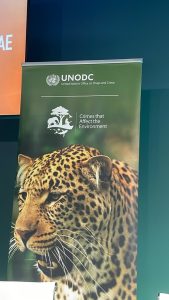ESA at COP28: Day 1 Continued
Blog Post by Malika El Mazhad
Today, December 1, was the first say of the World Climate Action Summit (WCAS) where world leaders descend on COP28 and the conference, country pavilions, and side events are in full swing. I started with a 10am joint session at the Food Pavilion between the Food and Agriculture Organization (FAO) and the International Atomic Energy Agency (IAEA) entitled ‘Climate Change and food security: The role of nuclear science’ which discussed the ‘Atoms4Food’ collaboration between the 2 agencies.

This partnership uses a series of nuclear science techniques to help solve specific problems, such as the loss of crop to rot through radiation techniques. The collaboration includes joint lab facilities and demonstrates a peaceful use of atomic energy to address food security and help build more resilience within the food systems. Dr. Cary Fowler, U.S. Special Envoy for Global Food Security, Office of Global Food Security was also on the panel and spoke about the importance of crop diversity, including a project on indigenous crop species which have been neglected but also hold nutritional value. At 11.45am most of the people in the Blue Zone were watching the opening ceremony of the WCAS which included speeches from the host country, King Charles III, United Kingdom, and The UN Secretary General and others. The message was clear that action is required, and much more must be done!
At 11.45am most of the people in the Blue Zone were watching the opening ceremony of the WCAS which included speeches from the host country, King Charles III, United Kingdom, and The UN Secretary General and others. The message was clear that action is required, and much more must be done!
My third session of the day was hosted by the Munich Security Council (MSC) entitled “Climate Security Moment: Assuming Joint Leadership” and was a very high-level panel that included Katrín Jakobsdóttir, Prime Minister of Iceland, Jens Stoltenberg, NATO Secretary General, and John Kerry, U.S. Special Presidential Envoy for Climate and others. This was a unique session that acknowledged the threat of climate change to peace and security. Katrín Jakobsdóttir spoke about the increased security threat to Iceland as the Arctic ice melts and new disputes over territorial borders begin. “Ecocide” was a new term that I had not heard before, however it was used to explain that deliberate targeting of the Kakhovka Dam which had a catastrophic aftermath.
 |
 |
 |
 |
After taking the time to finally grab a late lunch I enjoyed some of the scattered artwork around the conference rooms and then headed to my next session which was on the topic of the Global Methane Pledge specifically in relation to methane emissions from the waste sector. As methane is around 80 times more potent than Co2 and has peaked in the last 20 years panelists explained how this pledge compliments decarbonization efforts, and that solutions are relatively low cost.
 The role of biogas was also discussed and its ability as a sector to create 11-105 million jobs globally whilst providing a source for clean cooking and avoiding water contamination. I enjoyed this session as delegates seem to have high hopes for menthane reduction, so I wanted to be better informed on this topic.
The role of biogas was also discussed and its ability as a sector to create 11-105 million jobs globally whilst providing a source for clean cooking and avoiding water contamination. I enjoyed this session as delegates seem to have high hopes for menthane reduction, so I wanted to be better informed on this topic.
My final session was one of the last listed for the day at 6.30pm but was well worth hanging around for as it was hosted by the United Nations Office on Drugs and Crime (UNDOC) entitled “Crimes That Affect the Environment on Natural Carbon Sinks and Ecosystem Resilience” and did not disappoint. We heard from representatives of Peru and Brazil on their efforts to tackle illegal logging and mining activities and stop illicit crop deforestation. The numbers associated with these activities for this year alone demonstrated the scale of these problems.
The UAE also shared its plans to launch the ‘Abu Dhabi Call to Action’ on 3 December 2023 which trains law enforcement to better understand their role in handling and responding to climate emergencies and increase preparedness. A ministerial panel is also due to take place this COP28 on this topic which is the first of its kind. The Nature Crime Alliance was also highlighted in playing an active future role in tackling many of the mentioned issues in a collaborative cross border approach. Nature crime constitutes one of the largest illicit economies in the world and was a very informative end to the day.

As night fell on the second day of COP28 there was still a real buzz in the air, the days are long but totally worth it.
Read blogpost ESA at COP28: Day 1
https://www.esa.org/esablog/2023/12/06/esa-at-cop28-day-3-and-4/